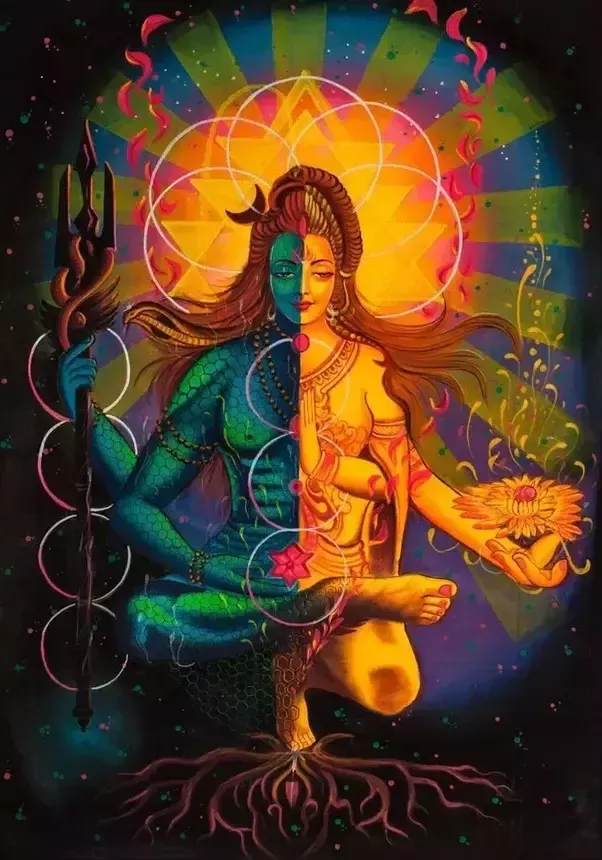9.5:CREATION OF THE PRINCIPLES OF THE SOUL:
From the remaining part of the unclean maya the siva
employs the sri-kanda-rudhra to stir the kalai principles. From the kalai
principle the moola pragrathi appears(fundamental physical bodies).
The fundamental physical matters are also called
fundamental bodies, the avyaktha,( sitham, guna,or the maan.)
From the guna(temperament) the buddhi(insight)emerges
From the insight the agankara (ego)emerges
From the ego three principles emerge.
1.saidhasa=brings information to the mind and
illuminates சைதச
2.vaigari=communicates with exteriorவைகாரி
3.boodhadhi=sensations=sensory experienceபூதாதி
Thr saidhasa are the perceptual organs lik
eye,ear,nose,tongue and skin these are the gnana indhriya(knowledge source
machines)
The vaigari are the arm,leg,mouth,uterus and the
rectum. These are kanma indhriyam(machines of action)
The boodhadhi are
the noise, taste,smell,light and the tactile . They are called
thanmathra (energy in the perceivable
form).
From, the boodhadhi the boodhas emerge. They are the
sky,wind, fire,water and the earth.
9.6:CREATION OF THE HUMAN BODY:
So far we have dealt with the creation of the maya(dark force) , the
siva thathvas, the vidhya thathvas and the anma thathvas. These issues have
detailed the creation of the universe from the dark force of maya. The maya is
responsible for the creation of the thought and the thought produces the
universe. This point is very important as the primary importance is given to
the thought and the mind. This is is
unique to the siddhantham philosophy as opposed to the other hindu schools.
Now we shall go to see how the siddhantha describes
the creation of the human body.
The human body is described to have five distinct
layers each over others. The layers are
1.ANANDHA KOSAM ஆனந்தகோசம்( HAPPINESS LAYER)=KARANA SAREERAM
2.VIGNANA KOSAM( KNOWLEDGE LAYER)=விஞ்ஞானகோசம்SANJUKA SAREERAM
3.MANOMAYA KOSAMமனோன்மயகோசம்(MENTAL LAYER)=GUNA SAREERAM
4. PRAMAMAYA KOSAMபிரமயகோசம்(LIFE SUPPORTING LAYER)=SUKUMA SAREERAM
5.ANNAMAYA KOSAM அன்னமயகோசம்(BODYMADE FROM FOOD)=DHOOLA SAREERAM
These five layer concept laid one over another is a
good model for the understanding of human physiology. It is nevertheless not
complete and it has to understood from the complete descriptions of the
thathvas and the thathveegas (which we shall see later).
This model of human physiology is a primitive human
physiology and does not correspond to modern human physiology. But it still has
some fundamental correctness and coul well have helped early siddha (antha)
medicine system.
The karana sareeram is closest to the soul and is made
up of maya itself ,it may be the early nervous system or the DNA.
The sanjuka sareeram is is made up of the viddhya
principles ” kalai,niyadhi,kalam,viddhai and aragam” and hence may be the
cerebral cortex.
The guna sareeram is made from the mind, buddhi and
ahangaram. it is closer to the modern model of FREUDIAN mind namely the
thought, higher mental function and the self.
The sukuma sareeram is one deals with perceptions like
eye, ear, tongue…etc. it is the perceptual organs generally.
The last is the dhoola sareeram is one closer to our
somatic body consisting of muscles, nerves, blood, heart, lungs, the basic biochemical foundations of the body
like hydrocarbons, proteins, enzymes ,hormones, water, energy bonds,
mitochondria…etc.
It is the dhoola sareeram which gets destroyed in each
birth. The other four sareera are not destroyed and reach the sivam. This is a common knowledge that our body
perishes at death. But our DNA is continued through children. The thoughts and
actions do not die as they exist for the benefit of the mankind long after our
death.

